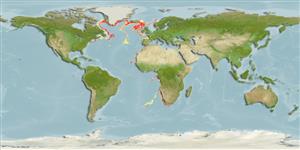Elasmobranchii (haaien en roggen) (sharks and rays) >
Rajiformes (Skates and rays) >
Rajidae (Skates)
Etymology: Malacoraja: Greek, malakos = soft + Latin, raja, -ae = ray, fis (Raja sp.) (Ref. 45335).
More on author: Barnard.
Environment: milieu / climate zone / depth range / distribution range
Ecologie
marien bathydemersaal; diepte 450 - 1570 m (Ref. 117245). Deep-water; 3°C - 5°C (Ref. 117245); 67°N - 38°S, 72°W - 25°E
Eastern Atlantic: Baffin Bay-Davis Strait Offshore to Iceland-Faeroe Ridge, off northwest Africa (Rio de Oro), off southern Namibia and South Africa.
Grootte / Gewicht / Leeftijd
Maturity: Lm ? range ? - ? cm
Max length : 70.0 cm TL mannelijk / geslacht onbekend; (Ref. 4426)
Korte beschrijving
Determinatiesleutels | Morfologie | Morfometrie
Very broad, almost pentagonal disc, light above and abruptly dark below; snout bluntly pointed with a flexible tip, eyes small and close together, and a disc with broadly rounded rear margins and tips (Ref. 5578). Small juveniles with and adults without thorns and covered only with small denticles (Ref. 5578). Slate-grey or greyish-brown above except rear margins of pectoral and pelvic fins and claspers of adult males which are dark brown; dark brown below, sometimes with light blotches (Ref. 5578). Lack of large thorns on its disc posterior to the scapular region (Ref. 6902).
A very rare species inhabiting continental slopes and probably down to the abyssal plains (Ref. 3167). Benthic (Ref. 58426). Adults usually at depths greater than 1,500 m while juveniles are mainly taken from about 450 m downward (Ref. 4426). Minimum depth reported taken from Ref. 4426. Feeds on crustaceans (Ref. 58426). Oviparous (Ref. 50449). Eggs have horn-like projections on the shell (Ref. 205). This species is occasionally captured as by-catch (Ref. 117245).
Levenscyclus en paargedrag
Maturities | Voortplanting | Spawnings | Egg(s) | Fecundities | Larven
Oviparous (Ref. 3167). Paired eggs are laid. Embryos feed solely on yolk (Ref. 50449).
McEachran, J.D. and K.A. Dunn, 1998. Phylogenetic analysis of skates, a morphologically conservative clade of elasmobranchs (Chondrichthyes: Rajidae). Copeia 1998(2):271-290. (Ref. 27314)
Status op de Rode Lijst van het IUCN (Ref. 130435)
Gevaar voor de mens
Harmless
Gebruik door de mens
Tools
Speciale rapporten
Download XML
Internetbronnen
Estimates based on models
Preferred temperature (Ref.
123201): 3.3 - 8.5, mean 5.9 °C (based on 122 cells).
Fylogenetische diversiteitsindex (Ref.
82804): PD
50 = 0.5625 [Uniqueness, from 0.5 = low to 2.0 = high].
Bayesian length-weight: a=0.00302 (0.00141 - 0.00645), b=3.24 (3.07 - 3.41), in cm total length, based on LWR estimates for this (Sub)family-body shape (Ref.
93245).
Trofisch niveau (Ref.
69278): 3.8 ±0.61 se; based on food items.
Weerstandsvermogen (Ref.
120179): laag, minimale populatieverdubbelingstijd 4,5-14 jaar (Fec assumed to be <100).
Fishing Vulnerability (Ref.
59153): Moderate to high vulnerability (48 of 100).
Nutrients (Ref.
124155): Calcium = 9.46 [1.70, 47.25] mg/100g; Iron = 0.362 [0.086, 1.103] mg/100g; Protein = 16.6 [13.7, 19.2] %; Omega3 = 0.61 [0.18, 2.41] g/100g; Selenium = 14.7 [3.9, 48.4] μg/100g; VitaminA = 7.61 [1.88, 30.80] μg/100g; Zinc = 0.341 [0.168, 0.630] mg/100g (wet weight);
